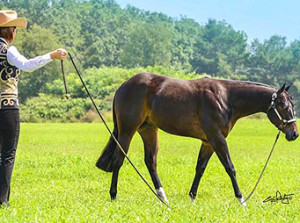Yearling Longe Line – It Doesn’t Deserve Such a Bad Rap
Click here to read the complete article106 – March/April, 2018
by Megan Ulrich
 The brain of a two-year-old prospect is something akin to a short-fused stick of dynamite crossed with a map that remains partly uncharted territory, or a mystery just clues away from being solved. But when that two-year-old has been handled, longed, and shown, prior to being ridden under saddle, their mental capacity can change significantly. That’s because competing with a yearling in an event like Longe Line, despite the sometimes bad rap it gets, can be a very beneficial practice when it comes to giving young horses a step up in the under-saddle training process. It can also make the transition into the riding classes significantly easier, but it’s only beneficial when it’s done well.
The brain of a two-year-old prospect is something akin to a short-fused stick of dynamite crossed with a map that remains partly uncharted territory, or a mystery just clues away from being solved. But when that two-year-old has been handled, longed, and shown, prior to being ridden under saddle, their mental capacity can change significantly. That’s because competing with a yearling in an event like Longe Line, despite the sometimes bad rap it gets, can be a very beneficial practice when it comes to giving young horses a step up in the under-saddle training process. It can also make the transition into the riding classes significantly easier, but it’s only beneficial when it’s done well.
Top trainers and some of the most decorated Longe Line competitors explain the do’s and dont’s of longeing young horses and the resulting benefits they’ve experienced when they start young horses that have had experience working in that 90-second circle.
Avoiding Pitfalls
Most people are familiar with the problems an improper Longe Line training program can create. From a physical standpoint, any repetitive activity can be detrimental to a young horse’s growing body. Mentally, entering a yearling that’s not mature enough into a training program can negatively impact their demeanor and sour them for the show pen. Additionally, some accuse Longe Line horses of having bad habits, such as cheating the gait and leaning their shoulders in to the center of the pen once they’ve started under saddle. However, all of that can be avoided with a sound training program and an exhibitor and trainer pair that understand the necessary, delicate balance between work and play for young horses.
Kenny Lakins of Lakins Quarter Horses warns against pushing young horses too much. “Once a colt learns what the circle is about, you really don’t have to do much more of the circles. You can pony them or turn them out, because they know their job. I’ve had clients that want to longe a lot once they’ve learned the circle, but there’s a border line there,” Lakins says. Approaching that line is like playing with fire. From pinned ears to hock issues, it doesn’t take long to wear out a young horse both physically and mentally.
“It seems that when the yearling knows its job, some clients start handling those horses way too much. They almost make them too babyfied – too much of a pet. They mess with them so often that the horse doesn’t even want to see them. You can see it in the horse’s body language. They get tired of being pestered all the time,” Lakins says.
Click here to read the complete article106 – March/April, 2018










